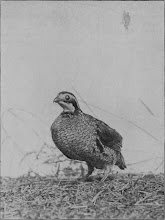
Wednesday 10 February 2010
Wednesday 3 February 2010
15

“O Pelandok, nuan enda tau enda bejimat,
Laban Bejampong seduai Pangkas
Ngiga tajau ke di lalai ka nuan.
Enti nuan enda bejimat
Tajau nuan deka di temu seduai.”
“Oh spirit of mousedeer,
You have to be careful,
As Bejampong and Pangkas,
Are looking for a jar,
That you have hidden.
If you are not careful,
They will find your jar.”
14
1. If you see a mousedeer (pelandok) coming towards you from the front, you have to return to your house and respect it with a day holiday. After this you must smear the place where you saw the mousedeer with the blood of one large cock or a hen to increase the effectiveness of the omen.
2. If you see a barking deer (kijang) coming towards you from the front, you must go home and respect it with three days holiday. After this you have to smear the place with the blood of two large chickens to increase its effectiveness.
3. If you see a sambar deer (rusa) coming towards you from the front, you have to respect it with five days holiday. After this, you have to smear the place where the deer was seen with the blood of a pig of any size.
 4. If you see a clouded leopard cat (Remaung daan) coming toward you from the front you have to stay away from work for seven days. After this, you have to smear the place with the blood of a sow which has three times delivered young or a male pig which already has tusks.
4. If you see a clouded leopard cat (Remaung daan) coming toward you from the front you have to stay away from work for seven days. After this, you have to smear the place with the blood of a sow which has three times delivered young or a male pig which already has tusks.
13
Monday 1 February 2010
9
When disturbed by some stimulus or frightened, slender lorises usually show slow, hesitating movements, often freezing to motionlessness for a limited time (a). Hiding of the conspicuously coloured face (b), hiding behind some cover (c) or flight to a high place (d) are also common signs of environmental stress due to some disturbance. When closely approached, the animal may try to defend itself by growling (d), other threat behaviour or attacks.

e: Hanging under the ceiling for a longer period after disturbance indicates rather severe stress; the animal may even sleep in this position (f). g: longer freezing in unusual, asymmetric postures has been observed in animals suffering from severe stress after transport to an unfamiliar environment; in such cases, protection from noise and other disturbance is very necessary.
h: Particularly in animals suffering from environmental stress, acoustic stimuli or sudden changes of light intensity may cause epileptoform seizures with saliva dripping from the mouth.
8

Identification 53-66 cm. Small, grey-brown goose. White patch at base of pink bill. Black belly patches. Yellow eye-ring at close range. Similar spp. White-fronted Goose A. albifrons larger, longer necked with bigger bill and less steeply sloping forehead. Adult less dark and has smaller white blaze on face and lack bright yellow eye-ring. Juvenile lacks pale eye-ring. Difficult to distinguish in flight except by longer neck and bill and relatively shorter wings. Voice Fast bouncing dyee yik. Hints Search flocks of other geese, particularly A. albifrons. Walks faster than A. albifrons and is consequently often found near the front of feeding flocks.

















